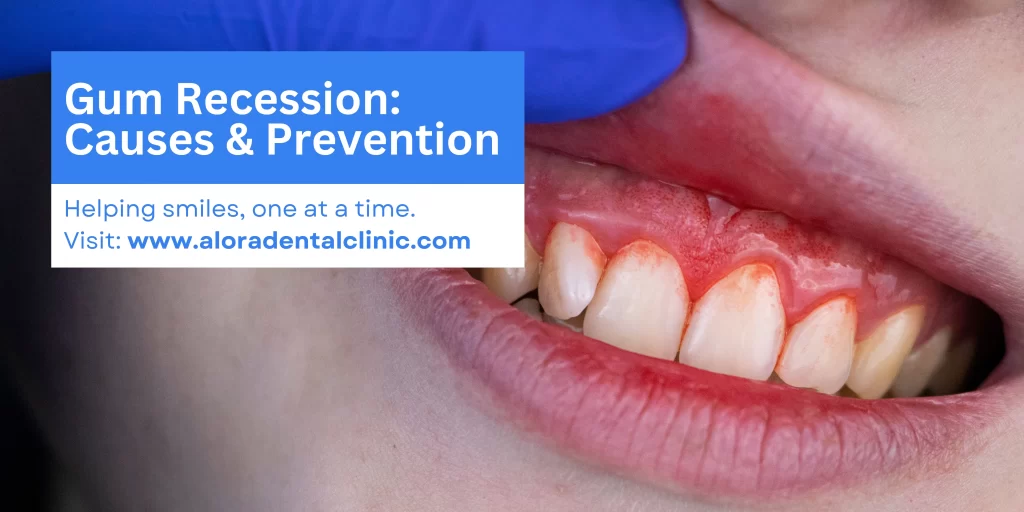Gum Recession: Causes, Treatments, and Prevention

Gum recession is a common dental issue where the gum tissue surrounding your teeth gradually pulls back, exposing more of the tooth or its root. While it may start out as a cosmetic concern, gum recession can lead to serious oral health problems like tooth sensitivity, decay, and even tooth loss. Understanding the causes, treatments, and preventive measures can help you protect your gums and maintain your smile.
What Causes Gum Recession?
Gum recession doesn’t happen overnight. It is often the result of several contributing factors, including:
- Aggressive Brushing: Brushing your teeth too hard can wear down your gums over time.
- Periodontal Disease: This bacterial infection damages the gum tissue and supporting bone.
- Genetics: Some people are simply more susceptible to gum recession due to their genetic makeup.
- Poor Oral Hygiene: A lack of consistent brushing and flossing can lead to gum disease and recession.
- Tobacco Use: Smoking or chewing tobacco can accelerate the recession process.
- Hormonal Changes: Women may experience gum sensitivity and recession during pregnancy, menopause, or other hormonal changes.
- Grinding and Clenching Teeth: These habits can put undue stress on your gums and teeth, leading to recession.
Symptoms of Gum Recession
Gum recession is not always immediately noticeable. However, there are key signs that indicate your gums may be receding:
- Tooth Sensitivity: Exposed roots can make your teeth more sensitive to hot, cold, or sweet foods.
- Visible Roots: You may start to notice that your teeth look longer or that the roots are becoming exposed.
- Loose Teeth: In severe cases, receding gums can lead to loose teeth, as the support structure weakens.
- Bleeding Gums: When brushing or flossing, you may notice some bleeding.
If you experience any of these symptoms, it’s crucial to see a dentist to assess the severity and recommend treatment.
Treatment Options for Gum Recession
Fortunately, gum recession can be treated. The right option for you depends on the extent of the recession and its underlying causes.
1. Scaling and Root Planing
This is a deep cleaning procedure where your dentist removes plaque and tartar from below the gumline. It helps halt the progress of gum disease and allows the gum tissue to reattach to the teeth.
2. Gum Grafting
For more severe cases, gum grafting surgery may be required. During this procedure, tissue is taken from another part of your mouth (or using synthetic materials) and grafted onto the affected area to cover the exposed roots.
3. Antibiotics
If gum recession is caused by infection, antibiotics may be prescribed to eliminate harmful bacteria and prevent further damage.
4. Dental Bonding
In mild cases, dentists may use a bonding agent to cover the exposed tooth root, reducing sensitivity and improving the tooth’s appearance.
How to Prevent Gum Recession
Prevention is always better than treatment. By adopting these habits, you can reduce the risk of gum recession:
- Use a Soft-Bristled Toothbrush: Brushing too hard can lead to gum damage. Opt for a softer toothbrush to protect your gums.
- Brush Gently: Use gentle, circular motions instead of harsh, back-and-forth scrubbing.
- Floss Daily: Cleaning between your teeth helps prevent plaque buildup that can lead to gum disease.
- Regular Dental Visits: Routine checkups can catch early signs of gum recession before they become a bigger problem.
- Quit Smoking: Tobacco use is a significant contributor to gum disease and recession.
Taking these proactive steps can help keep your gums healthy and prevent future recession.
Risks of Ignoring Gum Recession
Leaving gum recession untreated can lead to more severe complications, such as:
- Increased Tooth Sensitivity: As the gums recede, the root of the tooth becomes more exposed, leading to heightened sensitivity.
- Higher Risk of Decay: Exposed tooth roots are more prone to cavities, which can spread quickly if left unchecked.
- Tooth Loss: In severe cases, untreated gum recession can lead to the weakening or complete loss of teeth.
- Bone Loss: As the gums pull away, bone loss in the jaw may occur, leading to a weakened structure for supporting teeth.
When to See a Dentist
It’s important to visit your dentist at the first sign of gum recession. The earlier you address the problem, the more options you’ll have to prevent it from worsening. Your dentist can recommend the best treatment plan based on the severity of your gum recession and any underlying causes.
Conclusion

Gum recession is a common but serious dental issue that requires prompt attention. While it can’t always be reversed, early detection and treatment can prevent it from worsening. By maintaining good oral hygiene, addressing underlying causes, and seeking timely dental care, you can protect your gums and teeth from further damage.
At Alora Dental Clinic, we are committed to helping you maintain optimal gum health. If you’re concerned about gum recession or any other dental issues, book a consultation with us today!
FAQs
Additional Resources
For more information on dental health and preventive care, check out these resources:
Meet Your Dentist...
Step into Alora Dental Clinic and let us introduce you to our passionate and dedicated dentist, Dr. Angelica Eden Astillero. She’s the type of person who lights up a room with her warm and approachable demeanor. And that’s just the start of what makes her an exceptional dentist.
Dr. Astillero graduated from the University of the East, where she developed a love for dentistry and helping others. Her commitment to continuing education and the latest dental techniques allows her to provide top-notch care to patients of all ages. But what truly sets her apart is her ability to connect with her patients and put them at ease.

Get in touch!
Where to find us?
53 Narra St, Project 3, Quezon City, 1102 Metro Manila
Call us at:
0955-827-6875


